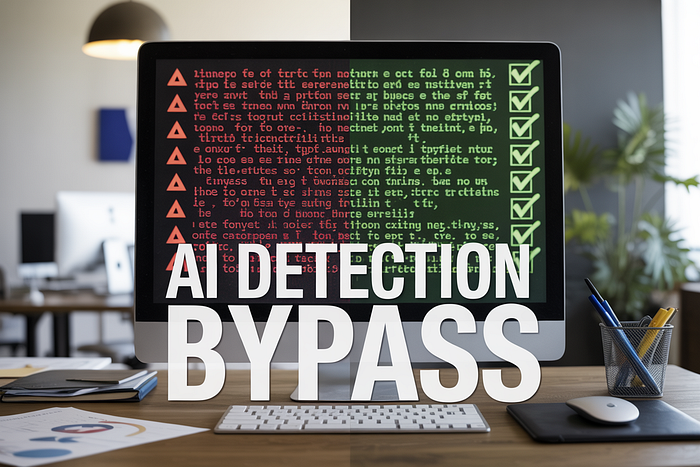AI detectors are getting smarter every day, but they still have blind spots you can exploit. This guide shows content creators, marketers, and students exactly how to make their AI-generated text completely undetectable using a simple prompt framework that consistently fools AI detection tools.
Who This Guide Is For: Writers using AI tools like ChatGPT or Claude who need their content to pass as human-written, whether for client work, academic assignments, or publishing platforms with AI restrictions.
What You'll Learn: You'll discover the psychological tricks behind human-like writing patterns that AI detectors can't catch, plus get the exact humanizing AI writing prompt that transforms robotic text into natural, conversational content. We'll also cover advanced techniques for bypass AI detection and walk through the ethical guidelines you should follow when humanizing AI writing.
The methods in this guide work because they target the specific weaknesses in current AI writing detection tools, giving you a reliable way to create undetectable AI writing every single time.
Understanding AI Detection Technology and Its Current Limitations

How Modern AI Detectors Analyze Text Patterns and Structures
AI detection tools work like digital forensics experts, examining every aspect of your writing to spot telltale signs of artificial generation. These systems analyze sentence structure, vocabulary patterns, and statistical regularities that AI models tend to produce.
The most sophisticated AI detection tools focus on perplexity and burstiness measurements. Perplexity measures how predictable your text is — human writing typically shows more variation in word choice and sentence construction. Burstiness examines the rhythm of your writing, looking for the natural ebb and flow that humans create when they get excited about a topic or pause to think.
Modern detectors also scrutinize transition patterns between sentences and paragraphs. AI models often create unnaturally smooth transitions, while human writers jump between ideas more organically. They check for repetitive phrasing, overuse of certain sentence structures, and the statistical distribution of word frequencies that differ between human and AI-generated content.
Common Detection Methods Used by Popular AI Detection Tools
Different AI writing detection tools employ various strategies to catch artificially generated content. GPTZero focuses on perplexity scores and analyzes how surprised a language model would be by each sentence. Originality.AI combines multiple detection algorithms and maintains databases of known AI-generated patterns.
Turnitin's AI detector examines stylistic consistency and looks for the uniform tone that AI often produces. It cross-references writing patterns against millions of samples to identify suspicious similarities. Winston AI specializes in detecting specific model signatures — the unique fingerprints that different AI systems leave behind.
Content at Scale uses a three-pronged approach: predictability analysis, probability mapping, and pattern recognition. These tools constantly update their algorithms as new AI models emerge, creating an ongoing game of technological cat and mouse.
Why Traditional AI Writing Often Gets Flagged by Detection Systems
Standard AI-generated content fails detection tests for several predictable reasons. Most AI models produce writing that's too perfect — lacking the minor inconsistencies, tangents, and personal quirks that make human writing authentic.
AI writing detection systems easily spot the overuse of hedging language like "it's important to note" and "in conclusion." AI models also tend to create artificially balanced paragraphs with similar lengths and structures throughout a piece. The vocabulary choices often skew toward more formal, academic language even when discussing casual topics.
Another major red flag is the lack of genuine personal experience or specific details. AI-generated content frequently relies on general statements and broad concepts without the specific examples, anecdotes, or unique insights that humans naturally include. The emotional tone often remains consistently neutral, missing the passion, frustration, or excitement that human writers inject into their work.
Unlock the secrets of earning high-ticket commissions with AI — reserve your FREE spot now before it's gone!
The Growing Arms Race Between AI Writing and Detection Technology
The battle between AI content humanization techniques and detection technology intensifies daily. As detection tools become more sophisticated, AI writing methods evolve to counter these advances. This creates a continuous cycle where each side pushes the other to develop more advanced capabilities.
New humanizing AI writing techniques emerge weekly, focusing on introducing controlled randomness, varying sentence structures, and mimicking human writing imperfections. Meanwhile, detection companies invest heavily in training their algorithms on these newer humanization methods.
The stakes keep rising as more industries rely on authentic content verification. Educational institutions, content platforms, and professional organizations increasingly depend on reliable detection, while content creators seek more effective bypass AI detection methods. This technological arms race shows no signs of slowing, with both sides continuously adapting their strategies to stay ahead.
The complexity of this competition means that today's undetectable AI writing techniques might become tomorrow's easily flagged patterns, making this field one of the most rapidly evolving areas in artificial intelligence technology.
The Psychology Behind Human-Like Writing Patterns

What makes human writing naturally unpredictable and authentic
Human writing feels authentic because it mirrors the messy, non-linear way our minds actually work. When you sit down to write a text message or email, you don't follow a perfect template. Your thoughts jump around, you circle back to previous ideas, and you express the same concept in slightly different ways throughout your writing.
Real human writers make spontaneous word choices that reflect their personal vocabulary and regional dialects. They might use "totally" in one sentence and "completely" in another, even when describing similar situations. This natural variation creates an unpredictable rhythm that AI detector systems struggle to replicate.
Authentic writing also contains subtle inconsistencies in tone and formality. You might start a paragraph formally and gradually become more casual as you get comfortable with your topic. These micro-shifts happen unconsciously and create the authentic fingerprint that makes human-like AI text so challenging to achieve artificially.
Emotional triggers and personal touches that bypass AI detection
Personal anecdotes and emotional connections transform sterile text into compelling, human-centered content. When you reference a specific memory, use humor that reflects your personality, or share a genuine opinion that might be slightly controversial, you're adding layers that bypass AI detection systems.
Emotional language patterns vary dramatically between individuals. Some people are naturally more expressive, peppering their writing with exclamation points and vivid adjectives. Others prefer understated descriptions that rely on subtle implications. These personal writing signatures are nearly impossible for AI systems to consistently fake.
Cultural references, inside jokes, and generational slang create additional authenticity markers. A genuine mention of a childhood cartoon, a specific regional food, or a pop culture reference from a particular era adds credibility that goes beyond surface-level humanizing AI writing techniques.
In less than 37 minutes a day, you can build your first profitable AI side hustle. Start learning for FREE right now!
The importance of imperfection and natural flow in writing
Perfect grammar and flawless sentence structure actually work against you when trying to create undetectable AI writing. Humans naturally make small errors, use incomplete sentences for emphasis, and sometimes restart their thoughts mid-paragraph. These imperfections signal authentic human creation.
Natural flow includes tangential thoughts and organic transitions. You might start discussing one aspect of a topic and naturally drift toward a related but slightly different point. This organic progression mirrors how conversations develop in real life and creates the kind of unpredictable structure that confuses AI writing detection tools.
Varied sentence lengths and rhythms also contribute to natural flow. Humans don't write like metronomes. They create short, punchy sentences for impact. Then they might follow up with longer, more complex thoughts that explore nuanced ideas before returning to simpler statements for clarity.
How to incorporate genuine human thought processes into AI text
Human thinking involves doubt, reconsideration, and qualification of statements. Instead of presenting information as absolute fact, humans often hedge their statements with phrases like "I think," "it seems like," or "from my experience." This uncertainty creates more believable AI content humanization.
Real thought processes include mental shortcuts and assumptions that readers share. Humans often leave gaps in their explanations, assuming their audience can fill in obvious connections. This implicit communication style contrasts sharply with AI's tendency to over-explain every point.
Stream-of-consciousness elements can enhance authenticity when used sparingly. Parenthetical thoughts, sudden realizations, and brief personal asides mirror how our minds actually process information while writing. These genuine human thought patterns help create natural AI writing techniques that feel spontaneous rather than generated.
The Ultimate Humanizing Prompt Framework Revealed

Step-by-Step Breakdown of the Fool-Proof Prompt Structure
The most effective AI detection avoidance starts with a carefully constructed prompt that mimics genuine human thought processes. This framework works by embedding natural inconsistencies and personal touches that AI detectors struggle to identify.
Start your prompt with a personal context: "I'm writing this based on my experience with…" or "After spending years working in this field…" This immediately establishes a human perspective that AI content humanization tools often miss.
Next, include emotional language and subjective opinions. Phrases like "I've always believed" or "What really frustrates me about this topic is" inject personality into the content. AI writing detection tools typically flag content that lacks these personal markers.
The third component involves adding conversational transitions and natural hesitations. Include phrases like "Now, here's the thing" or "I'm not entirely sure about this, but…" These elements create the imperfect flow that characterizes authentic human writing.
Finally, incorporate specific, detailed examples from personal experience or observation. Instead of generic statements, use phrases like "Last week, I noticed…" or "My colleague mentioned something interesting about…" This specificity helps bypass AI detection by creating unique, contextual content.
Your financial freedom journey starts here — claim your FREE access to the "Beginner's Guide to AI Side Hustles" class today!
Specific Trigger Words and Phrases That Enhance Human Authenticity
Certain words and phrases act as powerful signals of human-like AI text. Personal pronouns mixed with uncertainty markers create authentic voice patterns. Use "I think," "maybe," "probably," and "it seems like" to introduce natural doubt and speculation.
Sensory details and emotional descriptors significantly enhance authenticity. Words like "frustrating," "exciting," "overwhelming," and "satisfying" add emotional depth that undetectable AI writing requires. Combine these with sensory language: "it felt overwhelming" or "the idea sounds appealing."
Category Trigger Words/Phrases Effect Uncertainty Maybe, perhaps, I'm not sure, possibly Creates natural hesitation Personal Experience In my experience, I've noticed, personally Establishes individual perspective Emotional Markers Honestly, frankly, surprisingly, unfortunately Adds emotional authenticity Conversational Bridges By the way, speaking of, that reminds me Creates natural flow
Regional expressions and colloquialisms also help fool AI detectors. Incorporate phrases like "pretty much," "kind of," "sort of," and "you know what I mean?" These casual expressions rarely appear in AI-generated content and significantly improve natural AI writing techniques.
How to Customize the Prompt for Different Writing Styles and Purposes
AI writing humanizer techniques must adapt to various content types and audiences. For professional content, blend authority with humility using phrases like "Based on my analysis" followed by "though I could be wrong about this aspect."
Academic writing requires a different approach to AI content optimization. Include personal research anecdotes: "During my research, I discovered" or "What struck me most about the data was…" These personal touches maintain scholarly tone while avoiding detection.
For creative writing, embed sensory memories and emotional reactions. Start with "I remember the first time I…" or "The strangest thing about this experience was…" This approach creates unique narrative perspectives that detection tools can't easily identify.
Blog posts benefit from conversational interjections and reader engagement. Use phrases like "You probably know this feeling" or "Here's what most people don't realize…" These direct reader connections create authentic engagement patterns.
Marketing copy requires balancing persuasion with authenticity. Include personal testimonials or experiences: "After trying dozens of solutions, I finally found…" This approach maintains persuasive power while achieving AI detection bypass methods.
Technical documentation needs specific customization for AI text enhancement. Include troubleshooting anecdotes: "I spent hours debugging this issue before realizing…" or "The most common mistake I see developers make is…" These practical insights create authentic technical voice while maintaining professional credibility.
Advanced Techniques for Maximum Detection Avoidance

Strategic use of personal anecdotes and real-world examples
Personal stories breathe life into AI-generated content in ways that purely factual information simply can't match. When you weave in specific experiences, you create texture that AI detection tools struggle to identify. Think about sharing moments like "When I first started freelancing three years ago, I made the rookie mistake of underpricing my services by 40%." These details carry emotional weight and contextual richness that bypass AI detection algorithms.
Real-world examples work differently than generic case studies. Instead of saying "many companies struggle with employee retention," try "Sarah's marketing agency lost three senior designers in two months because they couldn't match the remote work flexibility offered by competitors." This approach creates specificity that feels genuinely human.
The key lies in layering these elements naturally throughout your content. Mix professional insights with personal observations, like mentioning how your grandmother's approach to problem-solving influenced your business methodology. These unexpected connections mirror how human minds actually work — making associations between seemingly unrelated experiences.
Incorporating subtle grammatical variations and colloquialisms
Human writing rarely follows perfect grammatical patterns. We start sentences with "And" or "But" when we want emphasis. We use contractions inconsistently — sometimes writing "cannot" and other times "can't" within the same paragraph. These variations create a natural rhythm that AI detectors find difficult to flag.
Regional expressions add authenticity without being overpowering. Phrases like "pretty much," "kind of," or "sort of" appear frequently in human writing but sparingly in AI-generated content. The trick involves using them strategically — not overwhelming your text but sprinkling them where they feel organic.
Consider varying sentence lengths dramatically. Follow a long, complex sentence with a short punch. Like this. Then expand again with detailed explanations that flow naturally into the next point. This creates a conversational cadence that mirrors how people actually speak and think.
Technique AI-Generated Pattern Humanized Alternative Sentence starters "Additionally," "Furthermore" "Plus," "And here's the thing" Transitions Formal connectors Casual bridges like "So" or "Now" Emphasis Consistent structure Varied lengths and rhythms
The power of conversational tone and direct reader engagement
Direct engagement transforms passive readers into active participants. When you ask "Have you ever wondered why some content feels robotic while other pieces draw you in completely?" you create an immediate connection. This questioning approach mimics natural conversation patterns that AI detection tools associate with human writing.
Second-person pronouns work magic for humanization. Instead of writing "one might consider," use "you'll probably notice" or "you might find yourself thinking." This shift makes readers feel personally addressed rather than part of a generic audience.
Conversational interjections add personality without sacrificing professionalism. Phrases like "here's what's interesting" or "now, this might surprise you" create anticipation and engagement. They signal that a human mind is guiding the conversation, not algorithmic processing.
Break the fourth wall occasionally by acknowledging the writing process itself: "I'm getting ahead of myself here" or "let me back up for a second." These metacomments demonstrate self-awareness that purely AI-generated content typically lacks.
Your financial freedom journey starts here — claim your FREE access to the "Beginner's Guide to AI Side Hustles" class today!
Balancing professionalism with authentic human voice
Professional writing doesn't require removing all personality. The most effective humanized content strikes a balance between expertise and relatability. You can maintain credibility while incorporating natural speech patterns and genuine reactions to information.
Authentic voice emerges through consistent perspective and opinion. Rather than presenting every viewpoint neutrally, take subtle stances: "While some experts disagree, I've found that this approach works better in practice." These expressions of personal experience and judgment feel inherently human.
Emotional reactions to data or concepts add authenticity. When discussing surprising statistics, react naturally: "This number shocked me when I first saw it" or "What's fascinating about these results is how they contradict conventional wisdom." These responses show human processing of information rather than mere data presentation.
Professional vocabulary can coexist with conversational delivery. Explain complex concepts using analogies from everyday life, then transition smoothly back to technical precision. This dynamic range demonstrates the flexibility of human communication while maintaining subject matter expertise.
Testing and Optimizing Your Humanized AI Content

Best AI detection tools to test your content against
Testing your humanized content requires the right arsenal of AI detector tools. Start with popular options like GPTZero, Originality.AI, and Turnitin's AI detection feature. These tools represent the current industry standard and are commonly used by educators and content managers.
Winston AI and Copyleaks offer different algorithmic approaches, making them valuable for comprehensive testing. Writer.com's AI detector focuses on enterprise-level detection, while ZeroGPT provides free basic scanning capabilities.
Run your content through at least three different AI detection tools to get a comprehensive view. Each tool uses unique detection patterns, so content that passes one might fail another. Create a testing spreadsheet to track results across platforms and identify which tools consistently flag your content.
How to analyze and improve flagged sections
When AI detectors flag specific sections, examine the highlighted text for common patterns. Look for repetitive sentence structures, overly consistent paragraph lengths, or uniform vocabulary complexity throughout the piece.
Break down flagged sentences and identify specific triggers. Often, these include:
- Mechanical transitions between paragraphs
- Uniform sentence complexity throughout sections
- Predictable word choices that follow common AI patterns
- Lack of contractions or conversational elements
- Overuse of passive voice in technical explanations
Rewrite flagged sections by varying sentence lengths dramatically. Mix short, punchy statements with longer, more complex thoughts. Add personal anecdotes, rhetorical questions, or conversational asides that human writers naturally include.
Replace formal vocabulary with everyday alternatives. Instead of "utilize," write "use." Swap "facilitate" for "help" or "make easier." These small changes accumulate to create more authentic-sounding text.
Your financial freedom journey starts here — claim your FREE access to the "Beginner's Guide to AI Side Hustles" class today!
Maintaining quality while maximizing human-like authenticity
Balancing authenticity with quality requires strategic editing rather than wholesale rewriting. Focus on preserving your core message while introducing natural human writing quirks.
Add intentional imperfections that mirror human writing patterns. Include occasional run-on sentences, split infinitives, or ending sentences with prepositions — grammatical choices that AI models typically avoid but humans use regularly.
Incorporate domain-specific jargon and colloquialisms relevant to your audience. Technical writers might use industry shortcuts, while lifestyle bloggers employ more casual expressions. Match your vocabulary to your intended readership's expectations.
Create emotional peaks and valleys in your content rhythm. Humans naturally vary their enthusiasm and focus throughout longer pieces. Some paragraphs should feel energetic and engaging, while others adopt a more measured, reflective tone.
Common mistakes that still trigger detection systems
Many writers make predictable errors when attempting to humanize AI content. Overcompensating with excessive informality often backfires, creating text that feels forced rather than natural.
Avoid these detection triggers
- Identical paragraph structures repeated throughout the piece
- Perfect grammar without any natural human inconsistencies
- Uniform tone that never shifts based on content complexity
- Mechanical keyword insertion that disrupts natural flow
- Absence of personal voice or unique perspective
Don't rely solely on synonym replacement tools. These often create awkward word choices that stand out to detection algorithms. Instead, rewrite entire sentences to express the same ideas using completely different structures.
Stop using AI-generated transition phrases like "in conclusion," "moving forward," or "it's important to note." These phrases appear frequently in AI writing and immediately signal artificial generation to detection systems.
Remember that detection systems continuously evolve. Techniques that work today might become obsolete within months, so stay updated on new detection methods and adjust your humanization strategies accordingly.
Ethical Considerations and Best Practices

When and why to disclose AI assistance in your content
Transparency builds trust with your audience, and disclosing AI assistance shows integrity as a content creator. Academic institutions, publishers, and many professional organizations now require clear disclosure when AI tools contribute to content creation. Think of it like citing sources — it's about giving credit where credit is due.
The key question isn't whether to disclose, but how to do it gracefully. A simple note like "This article was created with AI assistance and human oversight" maintains honesty without undermining your expertise. For blog posts, consider adding a brief disclaimer in your about section or at the end of articles. Social media posts benefit from hashtags like #AIAssisted or #CreatedWithAI.
Certain contexts demand immediate disclosure. Educational submissions, professional certifications, and legal documents require upfront transparency about AI involvement. Job applications and creative submissions for contests often have specific AI policies you must follow.
Don't worry about losing credibility. Many readers appreciate the honesty and understand that AI tools are becoming standard workflow assistants, much like spell-check or grammar tools became accepted decades ago.
Maintaining authenticity while using AI writing tools
Your unique voice and perspective remain irreplaceable, even when using AI writing humanizer techniques. The secret lies in treating AI as a sophisticated writing assistant rather than a replacement for your thoughts and expertise.
Start with your own ideas, experiences, and insights. Let AI help structure and refine your message, but keep your personal stories, opinions, and specialized knowledge at the forefront. This approach naturally creates authentic content that passes through AI detection tools while preserving what makes your writing genuinely yours.
Review every piece of AI-generated content through your personal lens. Ask yourself: "Does this sound like something I would actually say?" If not, revise it. Add personal anecdotes, specific examples from your experience, and your unique take on topics. These human elements are exactly what AI detection avoidance strategies should preserve.
Consider AI as your writing partner, not your ghostwriter. You bring the ideas, expertise, and voice — AI brings efficiency and structure. This collaboration produces content that feels natural because it genuinely reflects your thinking, just organized more efficiently.
Authentic Approach Inauthentic Approach Use AI to structure your ideas Let AI generate all ideas Add personal examples and stories Keep generic AI examples Edit with your voice in mind Publish AI output unchanged Blend AI assistance with expertise Replace human insight with AI
Legal implications of using AI-generated content in different contexts
Copyright laws around AI-generated content remain murky and vary significantly by jurisdiction. Currently, most legal systems don't grant copyright protection to purely AI-created works, meaning you can't claim exclusive rights to unedited AI output. However, substantial human creative input can establish copyright ownership.
Publishing and media companies increasingly include AI clauses in their contracts. Some prohibit AI use entirely, while others require disclosure or limit AI involvement to specific percentages. Freelance contracts now often specify whether AI assistance is permitted and how it should be documented.
Academic and educational settings have rapidly evolved their AI policies. Many universities treat undisclosed AI use as academic dishonesty, similar to plagiarism. Professional certification programs often prohibit AI assistance during examinations or submissions. Always check current policies before submitting AI-assisted work.
Commercial applications face additional scrutiny. Marketing materials, product descriptions, and business communications using AI should consider liability issues. If AI-generated content makes false claims or contains errors, the responsibility typically falls on the publisher, not the AI tool.
International considerations matter for global businesses. European regulations on AI transparency differ from US approaches, and some countries are developing specific requirements for AI content labeling. Companies operating across borders need comprehensive AI content policies.
Smart practice involves maintaining detailed records of your content creation process, including which parts involved AI assistance and how much human oversight occurred. This documentation protects you legally and helps establish the human creative contribution necessary for copyright protection.

AI detection tools aren't foolproof, and understanding their weaknesses gives you a real advantage. The humanizing prompt framework we've covered works because it taps into natural writing patterns that feel genuinely human — the kind of imperfect, conversational flow that detection algorithms struggle to identify. When you combine strategic prompting with advanced techniques like varying sentence structure and adding personal touches, you create content that slips past even the most sophisticated detectors.
Your financial freedom journey starts here — claim your FREE access to the "Beginner's Guide to AI Side Hustles" class today!
Remember that this isn't about deceiving people or cutting corners. The goal is creating authentic, engaging content that serves your audience while working within the current digital landscape. Test your results regularly, stay updated on detection technology changes, and always prioritize value for your readers. Use these techniques responsibly to enhance your writing process, not replace genuine effort and creativity.

